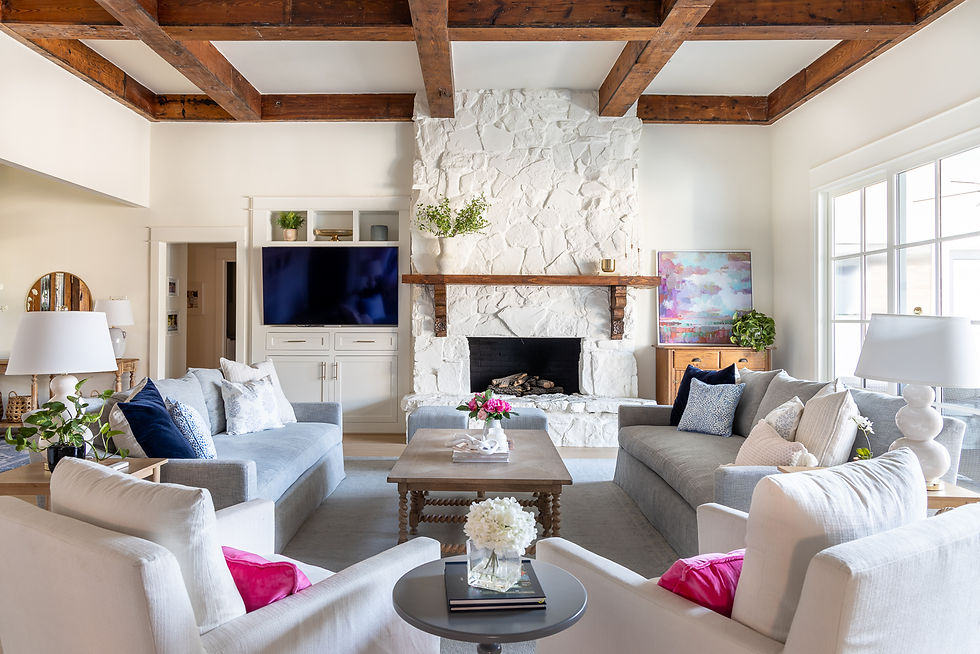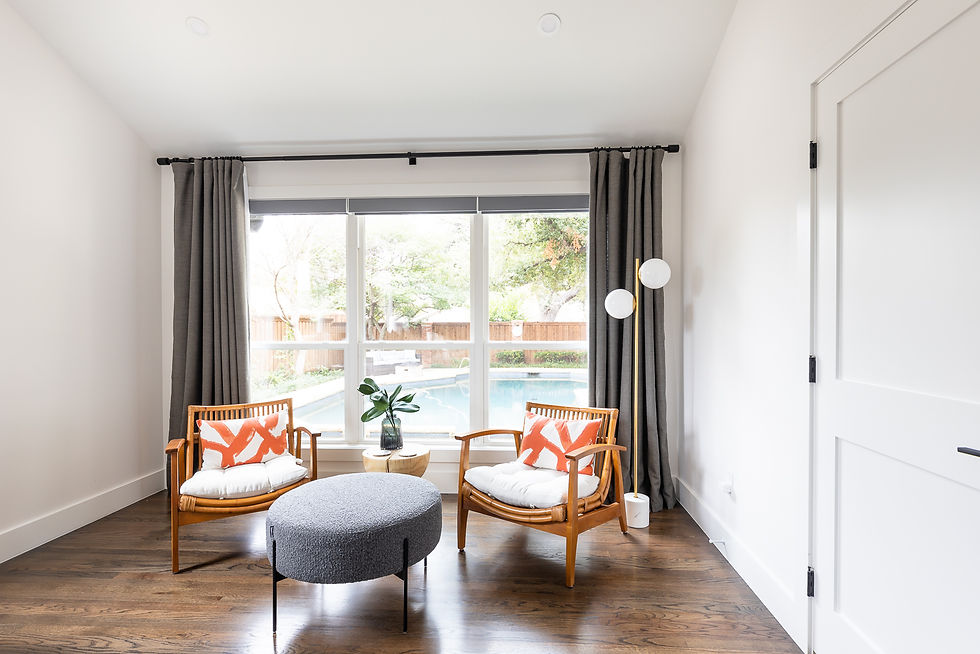
On nearly every project we work on, we get questions about how to mix wood tones in a home - "Is this going to look right with my dark floors? Is it too matchy matchy? Not matchy enough? HELP!"
We are BIG fans of mixing wood tones. If all of your woods are the same, things are going to get boring really fast. Mixing wood tones well is key to infusing some contrast and balance in your space. But, of course, there's an art to getting it just right. It's actually pretty similar to our rules on Mixing Metals! We'll show you how in 3 steps PLUS share our favorite woods to mix and match.
STEP ONE: IDENTIFY YOUR BASE WOOD TONE
Your base wood tone will be seen throughout your home, typically in your flooring or cabinetry. So, your base wood tone might be the chocolate brown of your wood flooring, or the warm honey color in your kitchen cabinets.
This may be something that already exists in your home and that you're going to be working with, OR it will be the new finish you're going to put down. It's going to run through the entire house, so you'll want to really love it. It's the foundation for everything we're laying on top of it.

In these two spaces, the predominant wood that we were working with is the darker brown beams.

STEP TWO: IDENTIFY UNDERTONES
The undertone of your base wood finish will dictate which wood tones you should layer into your home. At this point, if you're wondering "what on earth is an undertone?" - an undertone is a tone or color under the color you're looking at, that's sort of peeking through.
Have you ever chosen a cream colored paint, but when it goes up on the wall, it turns pink? This means it has a pink undertone. Or, it turns blue? Yep, the blue undertone is to blame. Nearly every finish has an undertone that needs to be identified.
Most wood undertones will fall in one of the following -
Orange/Warm - this is your classic honey colored cabinets from the 90's or original hardwoods from the 40's This is a warm undertone.
Gray/Cool - this has become more popular recently, a grayed-out stain on wood. This is a cool undertone.
Brown/Neutral - this tends to be the most enduring and balanced, which is why it's often our go-to. Not overly warm or cool; more of a neutral
A picture is worth 1000 words, so here are some examples of warm/orange, cool/gray, and brown/neutral undertones. You'll see that the undertone doesn't have any impact on whether a finish is light or dark.


Above, the wood floor and console are both neutral/brown in undertone. Below, the wood floor, stools, and vent hood are in neutral/brown undertones.

STEP THREE: START LAYERING IN LIGHTER AND DARKER TONES
Once you've recognized the undertone of your base wood finish, you can start to layer in different lighter and/or darker tones to create a balanced look. This is where undertones become extremely handy, as the fool-proof way to do this well is to layer in woods with the same undertone.
If your base wood finish is a warm floor, like a medium brown, start to layer in furniture pieces with a lighter wood in the same warm undertone. It's also important that different wood finishes have enough contrast so that they don't look like they were trying to match, but missed the mark. And, to create the perfect balance, try to carry coordinating wood tones throughout the entire home, so that everything feels tied together.

Above and below, the orange/warm undertoned medium brown wood floors are layered in with a lighter honey colored chair and vent hood.

Here are some of our easy, liveable wood pairing combinations.

We hope this gives you the road map you need to conquer mixing wood tones in your own home!



BUDAYA4DBUDAYA4DBUDAYA4DBUDAYA4DBUDAYA4D3PRIZETOTOMCITYTOTOPERAKTOTOVEGASTOGELBARCATOTOINDOWLATOTOSHOPTOTOSBOTOTOJITUANGKA
[10:44 PM, 3/26/2025] Customer service: <ahref="https://stonnies.shop/product/buy-male-performance-gummies/" rel="dofollow">Green Apple Aphrodisiac | Male Gummies</a>
<ahref="https://stonnies.shop/product/female-libido-gummies/" rel="dofollow">Cherry Aphrodisiac | Woman Gummies</a>
<ahref=" https://stonnies.shop/product/aphrodisiac gummies/" rel="dofollow">aphrodisiac gummies</a>
<ahref=" https://stonnies.shop/product/cdc gummy bears/" rel="dofollow">CBD Classic Gummies</a>
<ahref=" https://stonnies.shop/product/cdb-pain-gummies/" rel="dofollow">what are the best gummies for pain relief</a>
<ahref=" https://stonnies.shop/product/buy-cdb-sleep-gummies/" rel="dofollow">cbd with melatonin gummies</a>
<ahref="https://stonnies.shop/product/plus cbd calm gummies/" rel="dofollow">CBD Calm Gummies</a>
<ah…
[10:44 PM, 3/26/2025] Customer service: <ahref="https://stonnies.shop/product/buy-male-performance-gummies/" rel="dofollow">Green Apple Aphrodisiac | Male Gummies</a>
<ahref="https://stonnies.shop/product/female-libido-gummies/" rel="dofollow">Cherry Aphrodisiac | Woman Gummies</a>
<ahref=" https://stonnies.shop/product/aphrodisiac gummies/" rel="dofollow">aphrodisiac gummies</a>
<ahref=" https://stonnies.shop/product/cdc gummy bears/" rel="dofollow">CBD Classic Gummies</a>
<ahref=" https://stonnies.shop/product/cdb-pain-gummies/" rel="dofollow">what are the best gummies for pain relief</a>
<ahref=" https://stonnies.shop/product/buy-cdb-sleep-gummies/" rel="dofollow">cbd with melatonin gummies</a>
<ahref="https://stonnies.shop/product/plus cbd calm gummies/" rel="dofollow">CBD Calm Gummies</a>
<ahref="https://stonnies.shop/product/cbd-sleep-gummies-thc-free/" rel="dofollow">cbd sleep gummies thc free</a>
<ahref="https://stonnies.shop/product/plus cbd calm gummies/" rel="dofollow">plus cbd calm…
BUDAYA4D hadir sebagai toko penyedia voucher game Android online Terbaik dalam sepanjang masa! BUDAYA4D BUDAYA4D Paito SDY Paito China Paito HK Lotto Paito SDY Lotto
SLOT GACOR ini menjadi perbincangan hangat di kalangan pecinta judi online, terutama dengan kemunculan konsep Slot Maxwin. Bagi para pemain slot, mendapatkan maxwin atau kemenangan maksimal adalah impian yang selalu dikejar. Nah, kali ini kita akan membahas lebih dalam tentang Slot Maxwin di SLOT GACOR, serta tips dan trik untuk meraih kemenangan besar.
Nuansa permain dengan segelas minuman bourbon, vodka atau wishky sudah pasti dapat membuat > mamikagiftfloristballoon.com < melayang layang
katakan sejujurnya bahwa aku tampan dan pastikan anda membuka situs kami di link yang ada pada nama aku yah gess.. > nourislam.com <